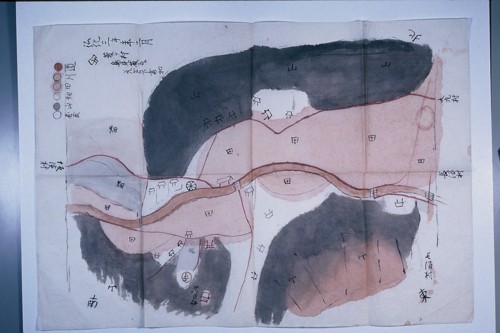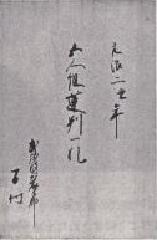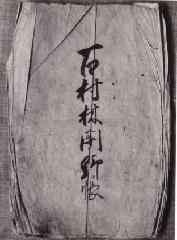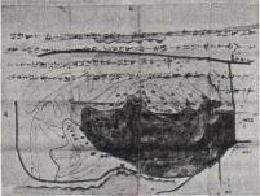Last updated: June 27, 2017

Picture of Hyakumura (Kouka 3rd year)
The Enomoto family in Hyakumura has 81 ancient documents from the Edo period. The contents of the ancient documents include the Land Survey Book (a land register in which fields were surveyed and the results compiled for each village), the Gonin Gumicho (a guarantee for annual tax collection, and crime prevention). There is a collection of historical materials that reveal the state of the 100 villages during the Edo period, such as account books (according to which a five-member group was jointly responsible for the purpose of the settlement) and village maps. The ancient documents were created over a period of 203 years, from 1667 to 1870. Among the valuable early modern documents, we will introduce particularly important basic historical materials. (The Enomoto family also preserves modern historical materials from the Meiji era onwards.)
This book was created in 1865 and records the agreements and prohibited items within the group. The most common clauses are related to annual tax payments, followed by clauses related to maintaining public order such as arresting bad people, land-related clauses such as buying and selling land, pawning land, etc. Provisions such as prohibition of poor harvests, encouragement of new fields, exclusion of delinquent acts by government officials against farmers, etc. are listed in ten bullet points. These prohibited items were created in response to the Edo Shogunate's laws and regulations, such as the Perpetual Prohibition of the Sale and Sale of Fields and the Keian Ofuregaki. I understand this.
This land survey book is thought to have been created during the land survey carried out in the Kanto territory in 1695. It is known that the oldest land survey conducted in the city was the Sakahama village survey conducted in 1594, but existing historical materials indicate that it was conducted in 1626. Following the Hirao village survey conducted in 1993, this Hyakumura survey conducted in 1988 is an older historical document that allows us to learn about the situation of the 100 villages in the early Edo period.
Houyou, a game in which a trained falcon is used to capture prey, has been practiced for a long time, and successive shoguns of the Edo Shogunate also enjoyed releasing hawks and maintained falcon farms. I proceeded. Although it was temporarily discontinued during the era of the fifth shogun Tsunayoshi, it was revived during the era of the eighth shogun Yoshimune, and the falconry system was improved and strengthened. The villages in the city area were designated as Torekaiba, a training ground for the falcons of the Zoshigaya-gumi falcon stable, and were frequently visited by falconers and officials related to the falconry. This historical document is based on a wholesaler at Fuchu-juku who sent the necessary items (firewood, charcoal, rice, etc.) to the Takaba official's lodging for the night at Shimofuda-juku. It was sent by a tonya (a caretaker) to the nanushi of a hundred villages. The villages of Inagi were responsible for transporting luggage and providing goods whenever the Takaba officials visited.
The Enomoto family has seven 100 Village Pictures that belong to the Edo period. Of these, two items, 67 and 68, are dated, and were created in 1667 and 1846. 67 (Kanbun 7) is a drawing that records the decision in a dispute between Naganuma Village and Hyakumura over the use of Iriaichi. A controversy arose when Naganuma Village used a field that had been used by Hyakumura, Sakahama, and Daimaru, and a lawsuit was filed with the Shogunate's review office. The ruling recognized Naganuma Village's right to join the village, but the annual tax was to be paid to the lords of the three villages. The illustrated map of 1968 (Kokai 3) is a very simplified illustration of 100 villages, with roads, rivers, rice fields, fields, forests, temples, mansions, etc. drawn in different colors.

"Gonin-gumi ichiban"

"Hyakuson Forest Open Field Book"

``Kaku'' (touch for Otakakata)

"Hyakumura Picture" (Kanbun 7th year)
Inagi City Education Department Lifelong Learning Division Tel: 042-377-2121